How to make sourdough starter
The path to great sourdough bread begins with healthy starter.
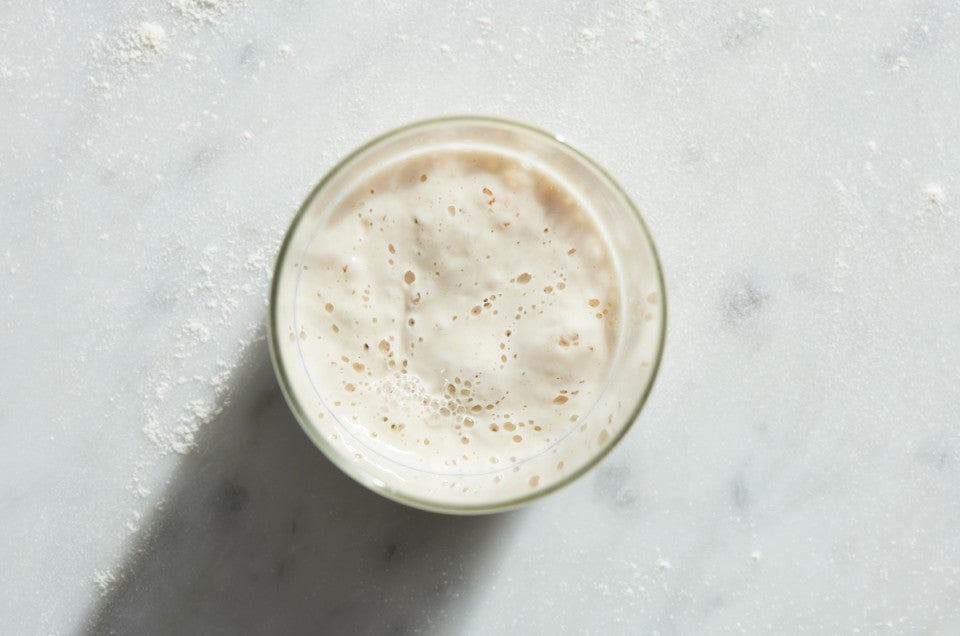

Have you ever wondered how to make sourdough starter?
Whether it conjures up a crusty loaf of bread or a bubbling crock of starter, sourdough is a treasured part of many bakers’ kitchens. But where does the path to sourdough bread begin? And how do you start?
Start in your own home kitchen, with flour and water. And begin by learning how to make your own sourdough starter.
First, a word of advice. Sourdough baking is as much art as science. This method for making sourdough starter isn't an exact match for the one you read on another site, or in a cookbook, or in your great-grandma's diary. If you have a process you've successfully followed before, feel free to stick with it. Or try this one and compare.
The following timeline assumes you can find a relatively warm place (68°F to 70°F) to grow your starter. More on that below. We also highly recommend using a scale: It will make this process much more accurate and much less messy. (But using measurement cups works, too, if necessary.)
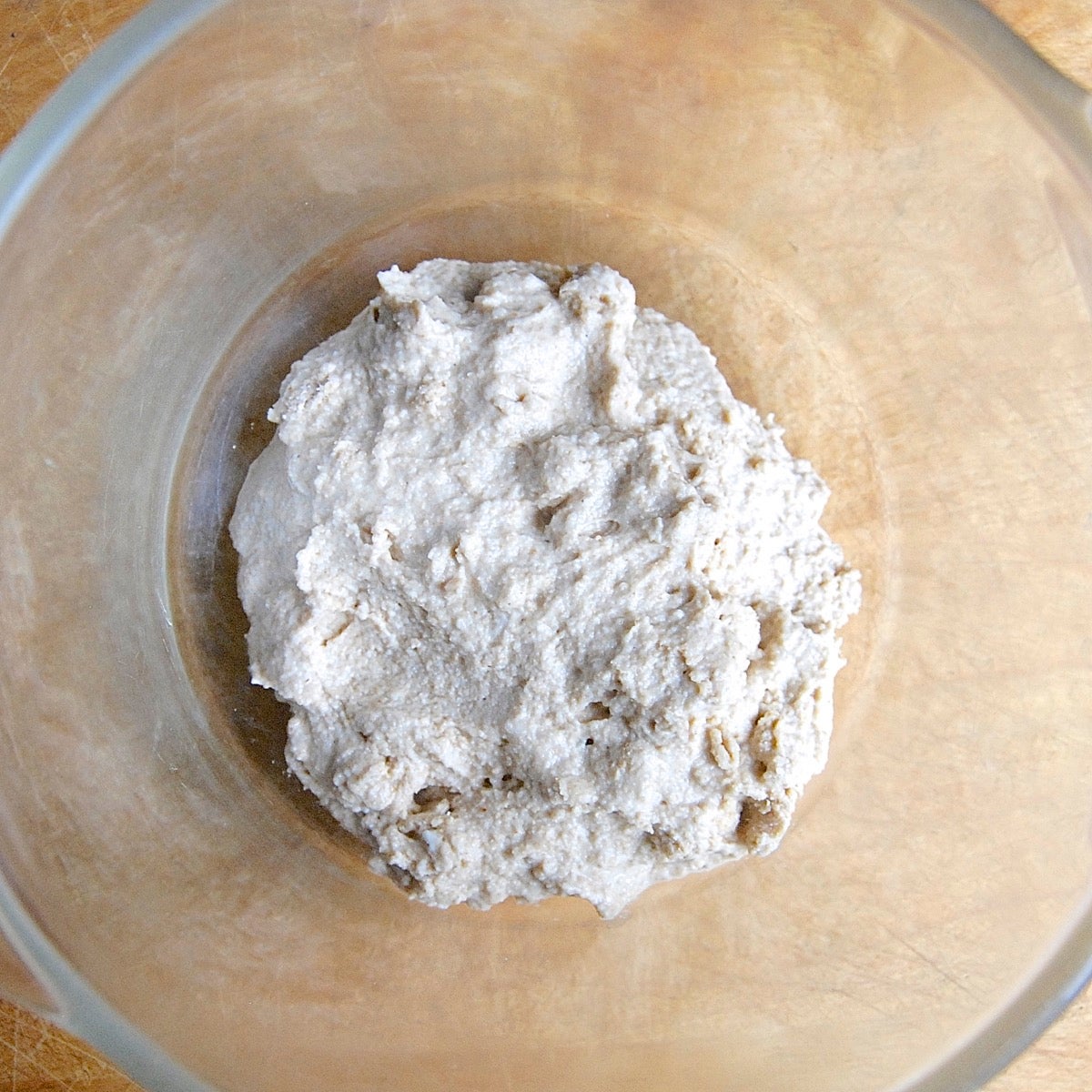
Combine 113g (1 cup) whole rye flour (pumpernickel) or whole wheat flour with 113g (1/2 cup) non-chlorinated cool water in a non-reactive container. Glass, crockery, stainless steel, or food-grade plastic all work fine for this. Stir everything together thoroughly; make sure there's no dry flour anywhere. Cover the container loosely and let the mixture sit at warm room temperature (about 70°F) for 24 hours.
A note about flour: You'll notice whole grain flour (whole wheat or rye) is used at the beginning of the process. This is because whole grains contain more nutrients and sourdough-friendly microorganisms than all-purpose flour. (Learn more in our post: Sluggish starter? Add a little whole grain flour.) After this first day, switch to using all-purpose flour.
A note about water: You also may have better results if you feed your starter with non-chlorinated cool water; from now on, we'll refer to this simply as "water."
A note about room temperature: The colder the environment, the more slowly your starter will grow. If the normal temperature in your home is below 68°F, we suggest finding a smaller, warmer spot to develop your starter. For instance, try setting the starter near a baseboard heater, or atop your water heater, refrigerator, or another appliance that might generate ambient heat. Your oven, turned off but with the light on, is another option, as is setting the container of starter on a folded dish towel laid atop a heating pad on its lowest setting. A temperature-controlled bread proofer or a sourdough home is the absolute ideal solution; if you bake lots of bread, consider investing in one of these tools.
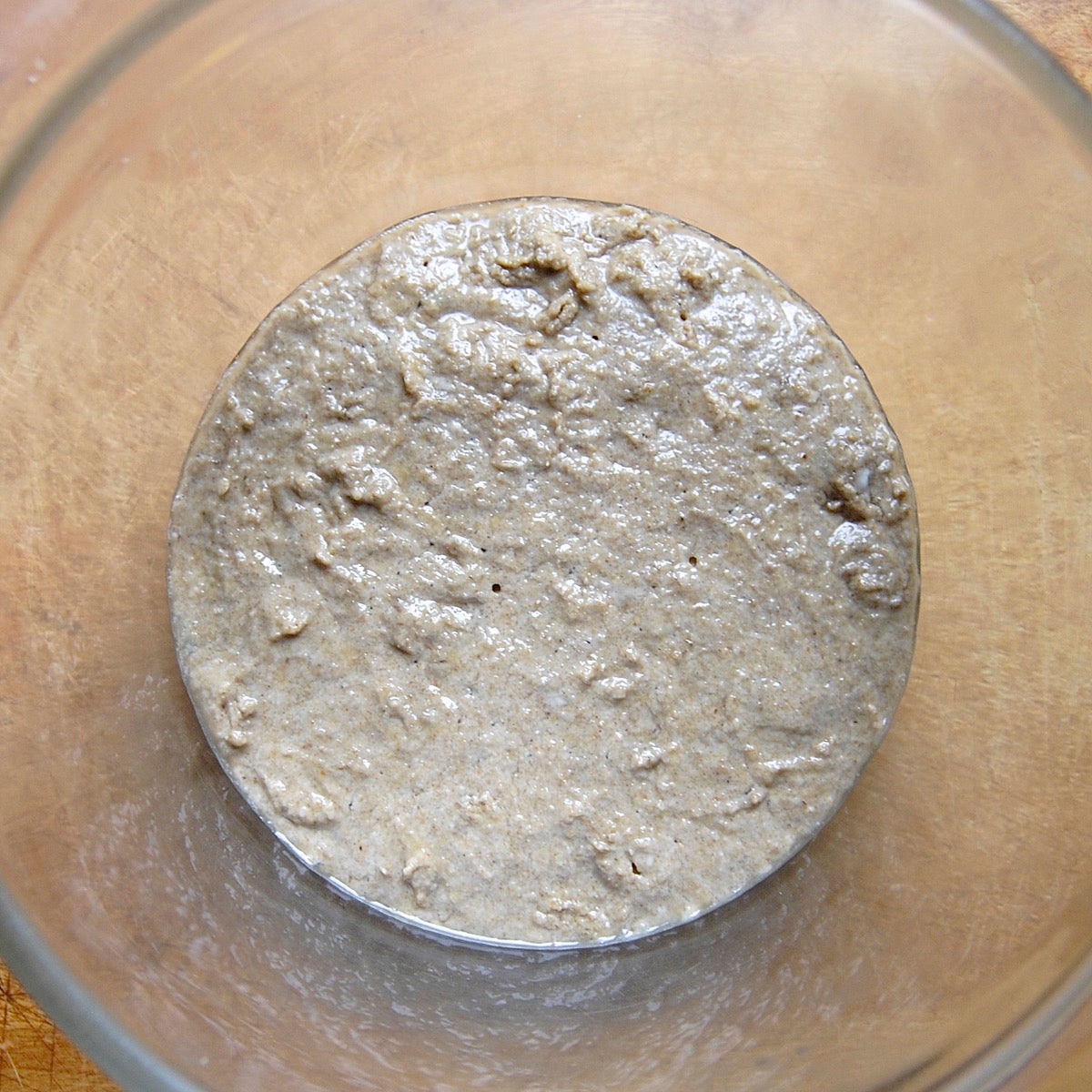
You may see no activity at all in the first 24 hours, or you may see a bit of growth or bubbling. Note that this starter looks fairly inert when viewed from up top.
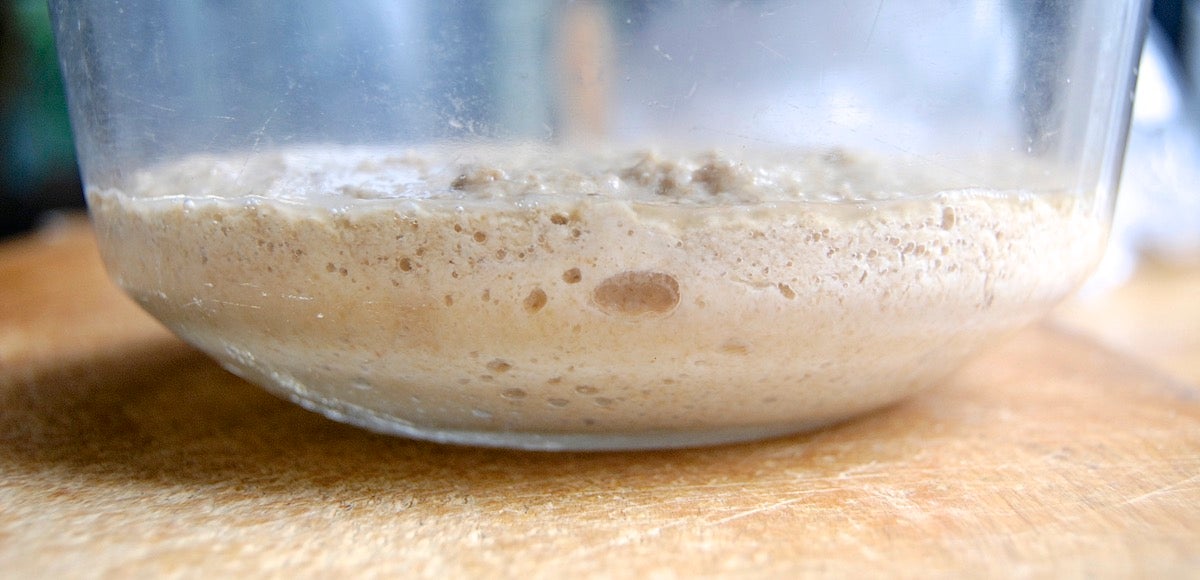
But when viewed from the side, you can see bubbles starting to form under the surface.
Either way, discard half the starter (113g; about 1/2 cup), and add to the remainder 113g (a scant 1 cup) King Arthur Unbleached All-Purpose Flour and 113g (1/2 cup) cool water (if your house is warm); or lukewarm water (if it's cold). Mix well, cover, and let the mixture rest at room temperature for 24 hours.
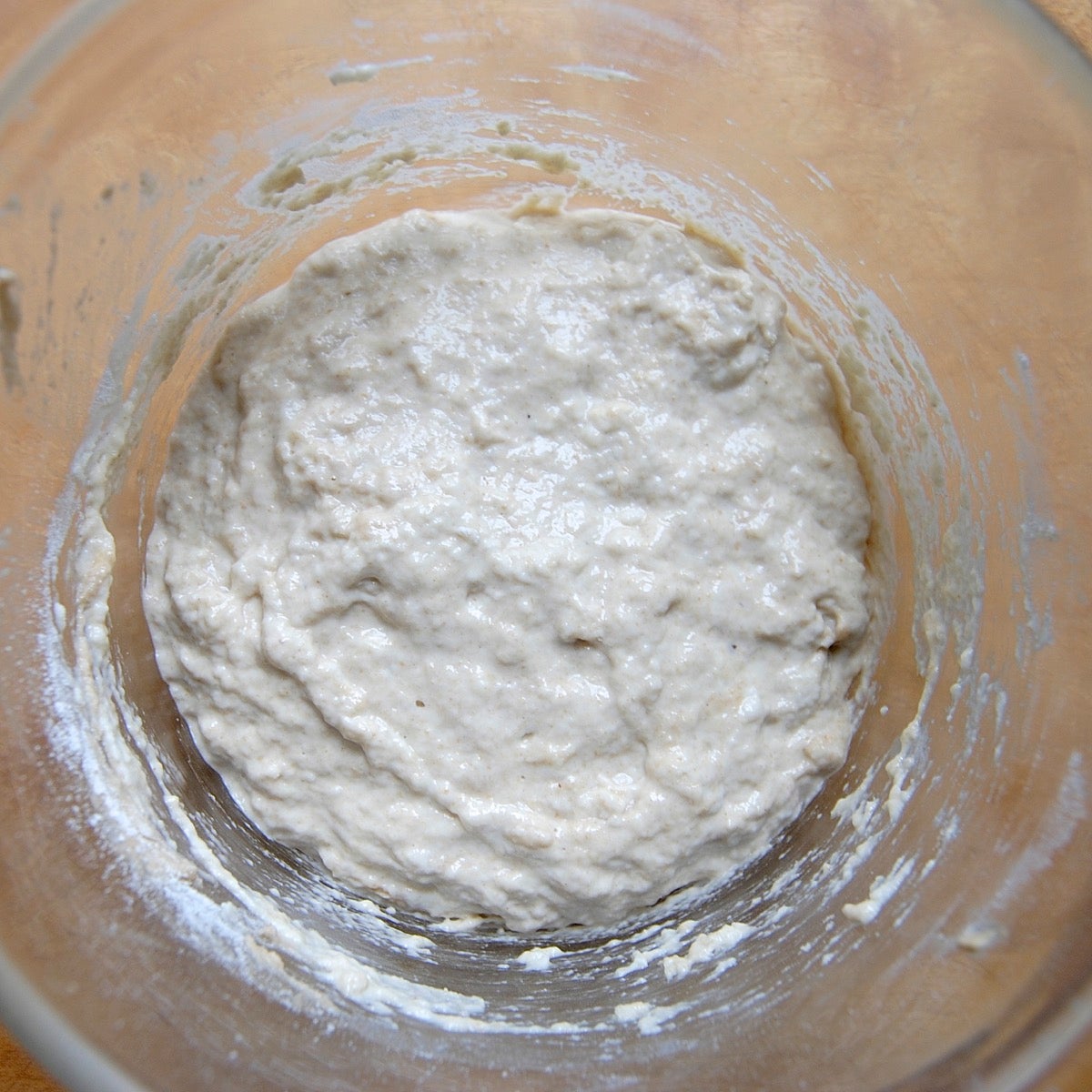
It's necessary for three reasons. First, unless you discard, eventually you'll end up with way too much starter. Second, keeping the starter volume the same helps balance the pH. And third, keeping the volume down offers the yeast more food to eat each time you feed it; it's not fighting with quite so many other little yeast cells to get enough to eat.
Also, you don't have to discard it if you don't want to; you can give it to a friend, or use it to bake. There are quite a few recipes on our site using "discard" starter, including sourdough pizza crust, sourdough pretzels, and my all-time favorite waffles. And if you still aren't comfortable discarding so much, consider maintaining a smaller sourdough starter.
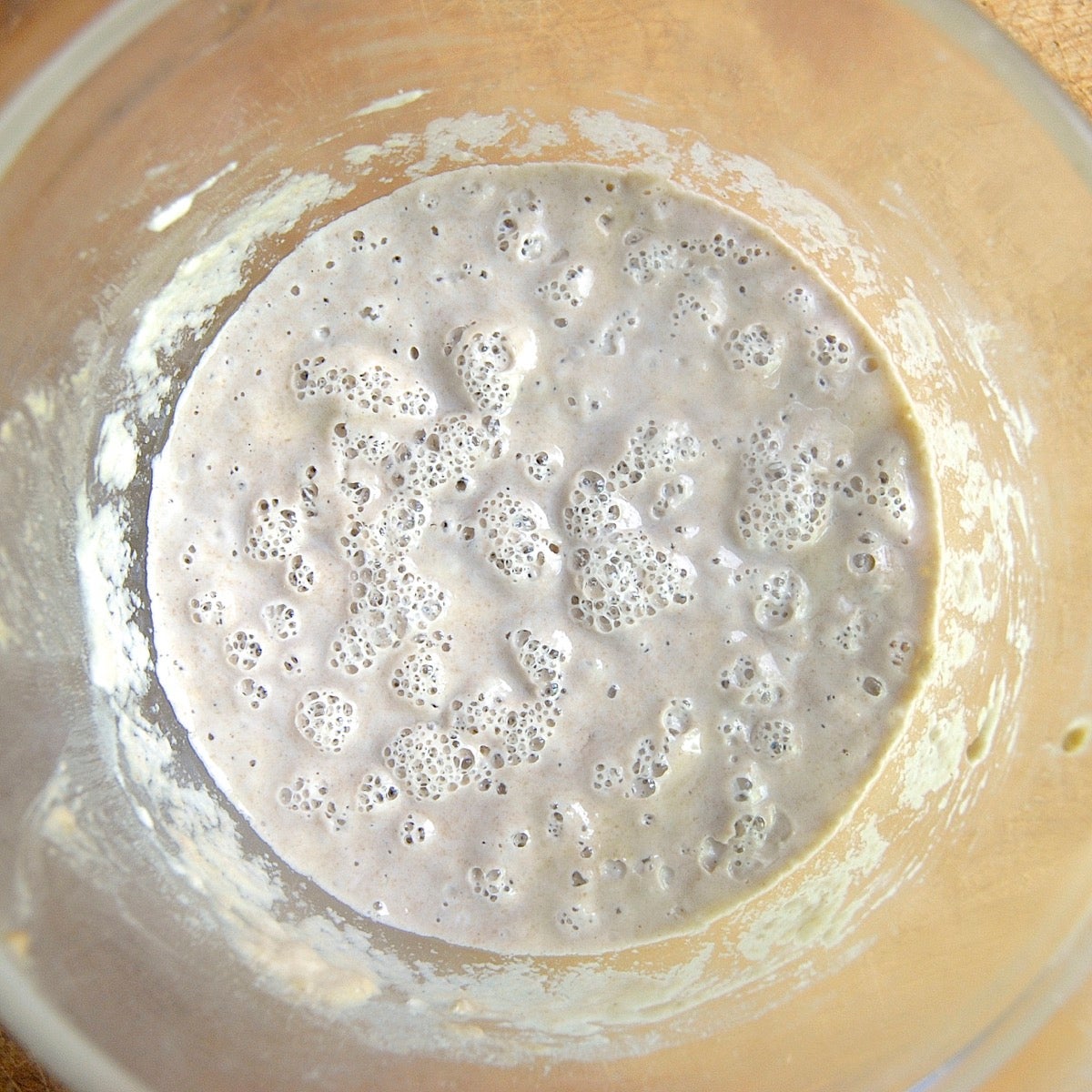
By the third day, you’ll likely see some activity — bubbling; a fresh, fruity aroma; and some evidence of expansion. The somewhat darker hue your starter got from its whole wheat beginnings will fade as you continue to feed it with all-purpose flour. It’s now time to begin two feedings daily, as evenly spaced as your schedule allows.
For each feeding, weigh out 113g starter; this will be a generous 1/2 cup, once it’s thoroughly stirred down. Discard any remaining starter.
Add 113g (a scant 1 cup) King Arthur Unbleached All-Purpose Flour and 113g (1/2 cup) water to the 113g starter. Mix the starter, flour, and water, cover, and let the mixture rest at room temperature for approximately 12 hours before repeating.
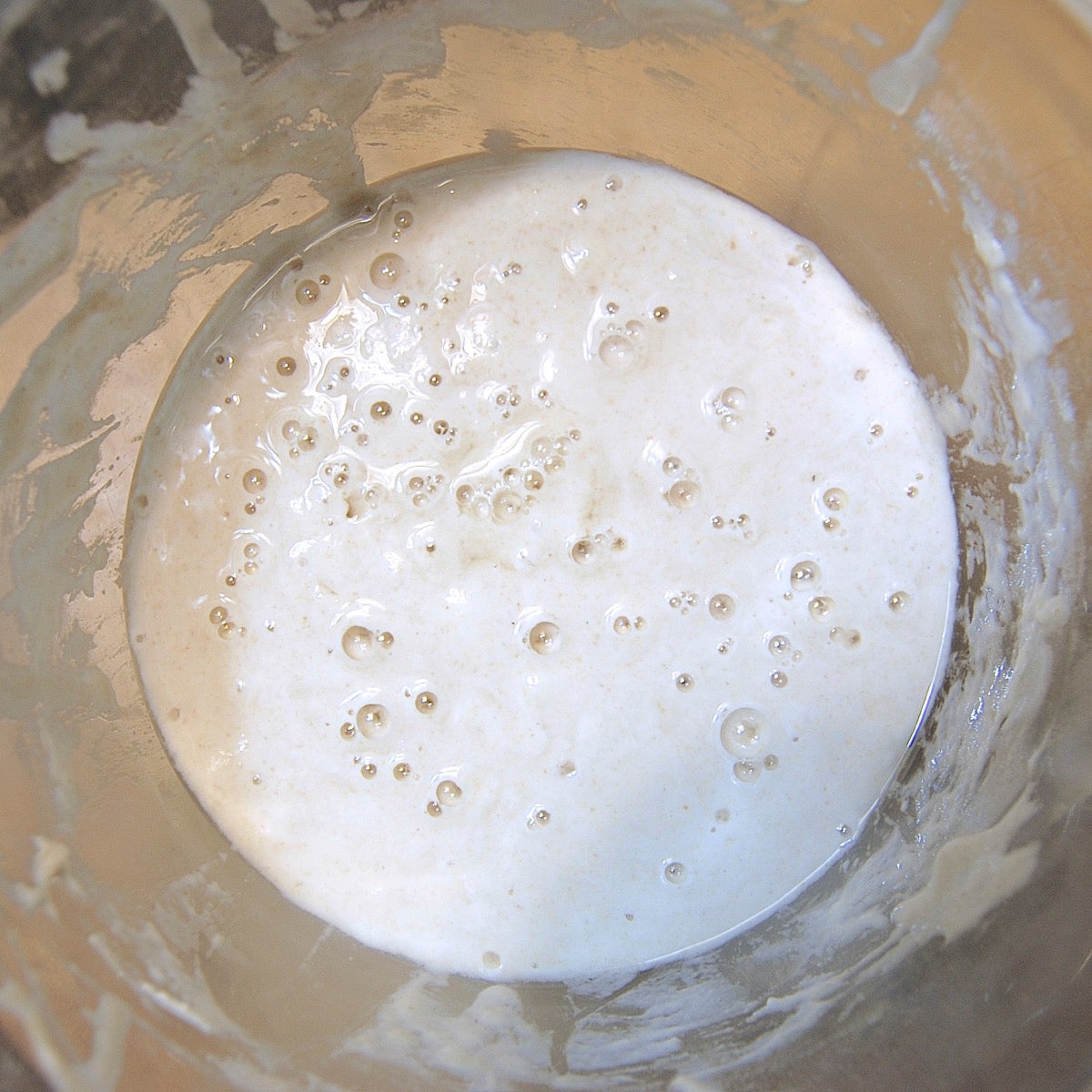
Here's the starter after its 12-hour rest. It may actually appear to be bubbling less than it did initially; this is normal.
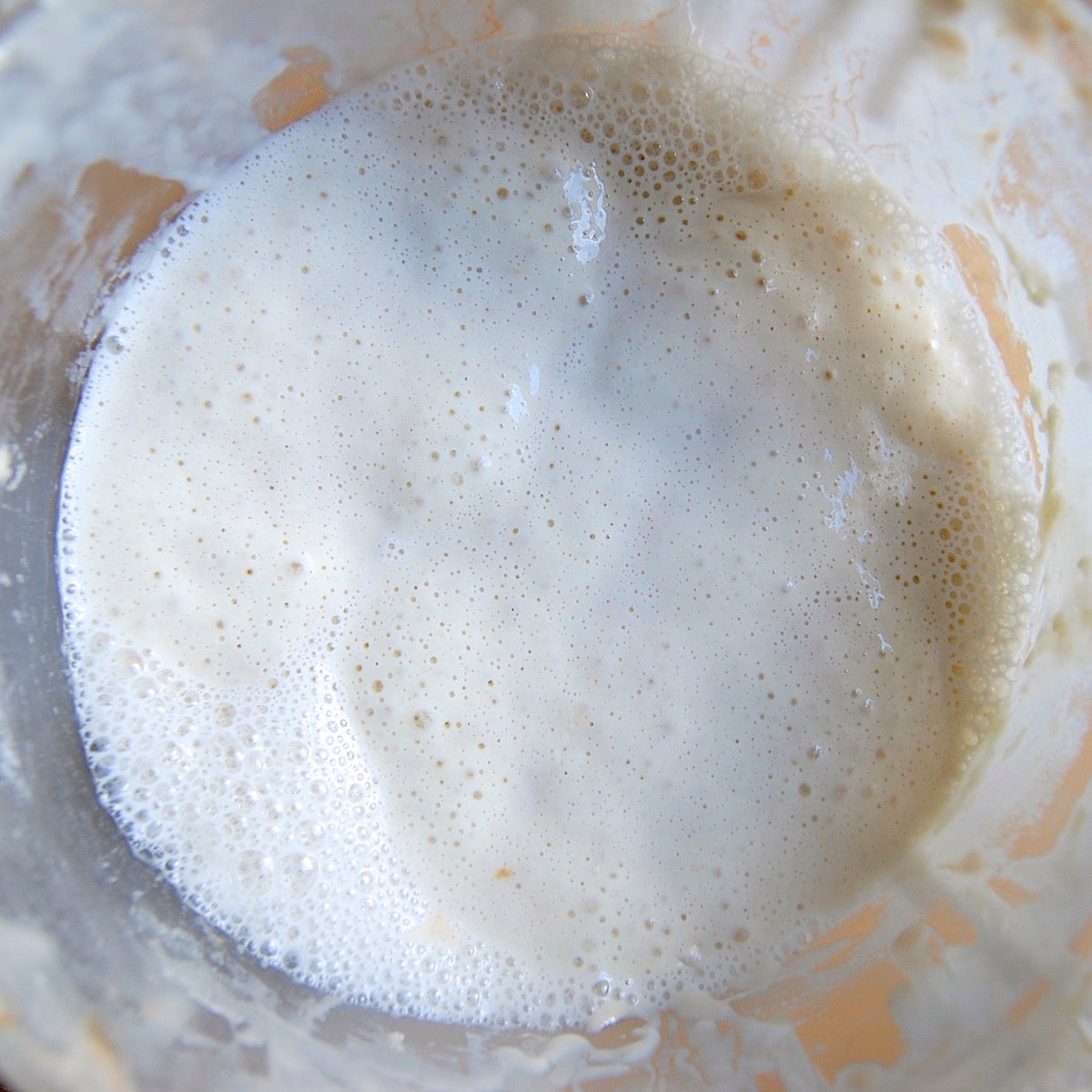
Repeat two-a-day feedings on days 4, 5, and as many days as it takes for your starter to become very active — almost foamy. If your starter is in cool surroundings, you may find it takes up to 2 weeks (or perhaps even longer) to get going.
When it shows a markedly different type of bubbling, though, it's just about ready to use.
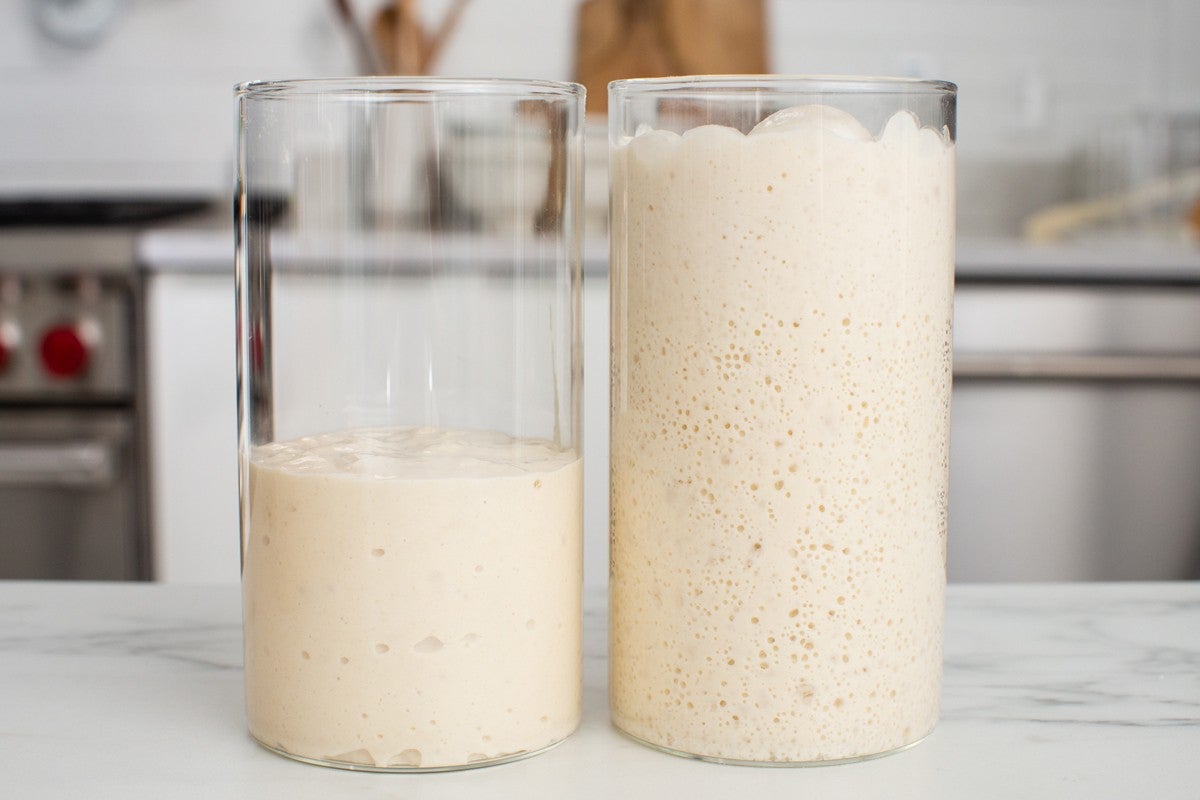
When you stir it down and feed it this time, make a note of how high it comes on the bowl or jar. You'll know it's ready to use in baking when it doubles in size in about 4 to 6 hours. You'll see lots of bubbles; there may be some little “rivulets” on the surface, full of finer bubbles. The starter should also have a tangy aroma — pleasingly acidic, but not overpowering.
When it gets to this point — doubling in size in 4 to 6 hours — give it one last feeding. Discard all but 113g (a generous 1/2 cup). Feed as usual. Let the starter rest at room temperature for 4 to 8 hours; it should be active, with bubbles breaking the surface.
Remove however much starter you need for your recipe (no more than 227g, about 1 cup); and transfer the remaining 113g of starter to its permanent home: a crock, jar, or whatever you'd like to store it in long-term. Feed this 113g of starter with 113g of flour and 113g of water.
Let it bubble and become active for several hours before covering it and placing it in the refrigerator.
No worries. If, after a week, your starter isn’t ready, don’t lose heart; keep feeding it regularly, and it will gain strength — really! Be patient. The conditions in your kitchen may be more or less conducive to building a starter, depending on room temperature, the season, humidity, or how much you’ve been baking.
Remember, the keys to developing a successful starter are:
Once your starter is doubling in size six to eight hours after being fed, it's ready to start baking. Here's what it should look like:
Now you're ready to bake with your starter! Try one of these beginner-friendly recipes:
No-Knead Sourdough Bread: This low-technique recipe relies entirely on sourdough starter for leavening. With a bubbly, active sourdough starter, a little bit of patience, and minimal effort, you’ll have a stunning, delicious loaf — all made without kneading.
Pain de Campagne (Country Bread): If you’re looking for a bit more of a challenge, try this recipe. Using unfed sourdough starter, minimal kneading, long fermentation, and baking in a hot Dutch oven are some of the techniques that make this naturally leavened, bakery-quality loaf simple to make at home.
Rustic Sourdough Bread: Because this recipe includes commercial yeast as well as starter, you're guaranteed a good, strong rise — even if your starter isn't quite up to snuff. If you’re just beginning to bake with sourdough starter and want some extra reassurance of success, this loaf is a great choice.
Note: In these recipes “ripe sourdough starter” refers to starter that has been fed and then doubled in volume and is showing signs of just beginning to sag under its own weight. The timing will be different depending on your sourdough starter and conditions, but generally, this occurs roughly eight hours after being fed. See more: Ripe sourdough starter: Here's what that means.
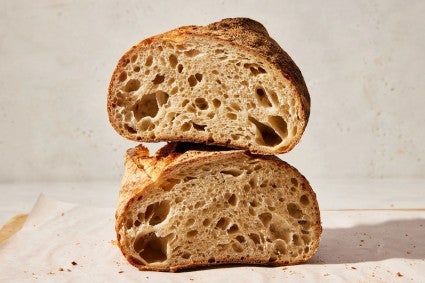
Don't worry — everything will be just fine. Starter is remarkably resilient. If you missed one feeding, just pick back up with your typical routine and your starter will settle in easily. If you missed a few feedings, simply keep feeding at room temperature every 12 hours until it doubles in size within 4 to 8 hours. Learn more in our post: What if I forgot to feed my starter?
Sourdough starter should smell sharply sour but "clean," with no overtones of spoilage, or any oddly chemical smell (think acetone). While the aroma of sourdough may make you draw back simply from its strength, it shouldn't be distasteful.
When your starter is neglected for an extended period, the liquid on top tends to turn from clear to dark-colored. That's OK; simply stir the liquid back into the starter and feed it the meal it's desperately craving. However, if your starter shows visible signs of mold, or an orange or pink tint/streak, or smells putrid, throw it out; it's been invaded by harmful microorganisms, and it's time to start over.
Want something printable to follow? See our recipe for Sourdough Starter.
Next: Maintaining your starter
Cover photo by Mark Weinberg; food styling by Liz Neily.
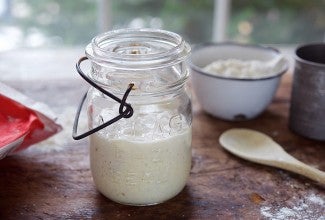


June 28, 2024 at 5:06pm
Hello! So, I'm on Day 9. I've been feeding diligently, twice daily, 12 hours apart. With every feeding, I see plenty of bubbles (it looks like one of your Day 3 photos). But 2 issues: 1) It doesn't seem to be rising (yet), and 2) it seems to have lost the tangy aroma it had around days 2 thru 4. It still smells pleasantly yeasty... but I really loved the sour aroma it had earlier. Can it get that back? I imagine I need to continue being patient with the rising bit. I did have one small snafu (day 4 or 5, I think) where I inadvertently discarded 113g instead of 226g, and fed the 226g with the usual 113g each of flour and water. I remedied this at the next feeding. Doesn't seem like that would have a huge effect, but maybe I'm wrong. It still bubbles every feeding, just doesn't seem to rise. Would doing a feeding with whole wheat help either of these things? Was hoping to bake this weekend, but not looking like my starter will be ready.
July 2, 2024 at 3:52pm
In reply to Hello! So, I'm on Day 9. I… by Jonathan (not verified)
Hi Jonathan! There is a known slowdown of fermentation in the starter building process which usually happens around day 3. Our best advice is simply to continue feeding and keeping it at a temperature around 70-75 degrees if possible. If your starter is still sluggish after 8 days of feeding twice a day, give it a feeding with a whole wheat flour to boost things along. The tangy aroma should return once the starter is mature enough to double in size reliably.
May 24, 2024 at 10:07am
Once the starter is being store in the refrigerator, how do you go about bringing it out to use and bake with?
May 24, 2024 at 3:54pm
In reply to Once the starter is being… by Stacey (not verified)
Hi Stacey, once your starter is fully mature and ready for baking, you can store it in the refrigerator for up to week. When you take it out, you'll generally want to feed it straight from the refrigerator and allow it to ripen before adding it to your bread recipe. Ideally you want to see your starter double within 6-8 hours after a feeding as a good sign that it is active enough to leaven your bread. If your starter seems sluggish, you may find that a few feedings at room temperature will be helpful after refrigeration and before you bake bread, especially if you're planning to bake a recipe that is entirely naturally leavened (no added yeast). Check out our Feeding and Maintaining Your Sourdough Starter recipe for more tips on how to activate your starter after refrigeration.
May 12, 2024 at 5:04pm
I'm on day 13 and my starter is bubbling and it's rising but it isn't doubling in size. It's rising at about half it's size. I was thinking of feeding it with 10 percent whole wheat flour is that appropriate for a new starter? Any other ideas?
May 13, 2024 at 11:24am
In reply to I'm on day 13 and my starter… by Mary (not verified)
Hi Mary, it sounds like your starter is a little sluggish and adding 10% whole wheat flour to each feeding might give it just the boost it needs. If you're following our sourdough starter recipe, I would also be sure to feed it twice daily, and in order to see the type of doubling you're looking for, it's best to store your starter in a clear, straight-sided quart-sized jar that is taller than it is wide. A wide mouth canning jar works well for this. It can be more difficult to see the starter doubling if you have it stored in a wide bowl or Tupperware container.
April 16, 2024 at 11:53am
The last time I tried a sourdough starter, I got over a week in and then some stray mixture at the top of the vessel in which I was keeping it got moldy. Should the entire vessel be cleaned between feedings? How can I prevent mold from growing outside of the main body of the starter as it matures?
April 19, 2024 at 3:49pm
In reply to The last time I tried a… by Patrick (not verified)
Hi Patrick, during the creation process a sourdough starter is more vulnerable to mold and unhelpful bacteria because it has not yet developed the natural defenses that a mature starter possesses. During this time, stirring the starter well after each feeding can help prevent mold from taking root (mold needs oxygen to grow and starts on the surface, so stirring the starter well each day can help disrupt mold development). It really isn't necessary to clean the container each time you feed your starter, but it can be helpful to scrape down the sides with a silicone spatula. If you're not already doing so, I'd also recommend covering your starter container with plastic wrap or a lid set loosely on top. Once your starter is rising, it's important to begin twice daily feedings. Ideally you don't want to let the starter fall significantly between feedings when you're maintaining it at room temperature. Feeding it in this way will help keep your starter healthier and more active as it matures.
April 15, 2024 at 10:01am
Is it necessary to feed your starter twice a day in the beginning?
April 15, 2024 at 11:36am
In reply to Is it necessary to feed your… by Diana (not verified)
Hi Diana, when you're first creating a starter from scratch, it's fine to feed only once a day until the starter begins to rise consistently (twice). Occasionally you'll see an early rise on day 1 or 2 that is caused by a bacterium that gives off carbon dioxide. It's best to ignore this rise and wait for the starter yeast to kick in and cause the starter to rise two days in a row. When you see this kind of rising behavior, you'll want to begin feeding twice daily, which will help keep the yeast more active and vigorous. It's also important to stir your starter well each day during the creation process, as this can help prevent mold from developing.
Pagination